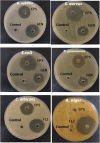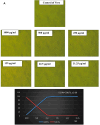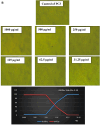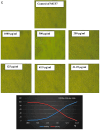Production and characterization of exopolysaccharides from Pseudomonas aeruginosa AG01 with some medical potential applications
- PMID: 40369557
- PMCID: PMC12077034
- DOI: 10.1186/s12934-025-02730-z
Production and characterization of exopolysaccharides from Pseudomonas aeruginosa AG01 with some medical potential applications
Abstract
There is growing interest in the production and characterization of bacterial exopolysaccharides (EPS) because of their diverse range of applications. This study aimed to examine the production of EPS by Pseudomonas aeruginosa AG01, to characterize the produced EPS and its application as antioxidant, antimicrobial, antibiofilm, antitumor, and antiviral activity. The results indicated that the ideal conditions for achieving the highest production of EPS included an incubation period of 96 h, a pH level of 6, and a temperature of 32 °C in a nutrient broth medium. The most efficient sources of carbon and nitrogen for the formation of EPS were found to be galactose, glucose, yeast extract, and peptone. Several functional groups were confirmed to be present by Fourier transform infrared spectroscopy including amino groups, amides, carboxylic acids, hydroxyl groups, and phosphates. In the same respect, EPS has antioxidant activity. Moreover, EPS produced by Pseudomonas aeruginosa AG01 demonstrated antibacterial activity against various Gram-positive, Gram-negative bacteria, and yeast, besides antibiofilm activity about 98.93%, 98.86%, 98.63%, and 97.19% for Bacillus subtilis, Staphylococcus aureus, Klebsiella pneumoniae, and Escherichia coli, respectively as well as anticancer activity against prostate cancer (PC3) and breast cancer (MCF7) cells with IC50 values of 156.41 and 156.41 µg/ml, respectively. Flow cytometry analysis revealed that MCF7 cells treated with EPS at a concentration of 500 µg/ml for 48 h showed a reduction in the percentage of cells in both the G0/G1 and S phases compared to the untreated control MCF7 cells. EPS resulted in apoptosis induction in MCF7 cells using the Annexin V-FITC PI staining method. The findings indicate that EPS demonstrates significant antiviral activity against both the herpes simplex virus (HSV-1) and the hepatitis A virus (HAV). In conclusion, EPS has great potential to be developed as a natural antioxidant or used in medicine and pharmaceuticals.
Keywords: Antibiofilm; Antimicrobial; Antioxidant; Antitumor; Antiviral; FT-IR; HPLC.
© 2025. The Author(s).
Conflict of interest statement
Declarations. Ethics approval and consent to participate: Not applicable. Consent for publication: Consent for publication has been obtained from all authors. Competing interests: The authors declare no competing interests.
Figures










Similar articles
-
Production, Characterization and Valuable Applications of Exopolysaccharides from Marine Bacillus subtilis SH1.Pol J Microbiol. 2017 Dec 4;66(4):449-461. doi: 10.5604/01.3001.0010.7001. Pol J Microbiol. 2017. PMID: 29319513
-
Functional characterization and biotechnological applications of exopolysaccharides produced by newly isolated Enterococcus hirae MLG3-25-1.Int Microbiol. 2025 Apr;28(4):851-862. doi: 10.1007/s10123-024-00587-7. Epub 2024 Sep 2. Int Microbiol. 2025. PMID: 39222179
-
Antimicrobial and antibiofilm activity of biopolymer-Ni, Zn nanoparticle biocomposites synthesized using R. mucilaginosa UANL-001L exopolysaccharide as a capping agent.Int J Nanomedicine. 2019 Apr 10;14:2557-2571. doi: 10.2147/IJN.S196470. eCollection 2019. Int J Nanomedicine. 2019. PMID: 31118605 Free PMC article.
-
Exopolysaccharides from yeast: insight into optimal conditions for biosynthesis, chemical composition and functional properties - review.Acta Sci Pol Technol Aliment. 2015 Oct-Dec;14(4):283-292. doi: 10.17306/J.AFS.2015.4.29. Acta Sci Pol Technol Aliment. 2015. PMID: 28068035 Review.
-
Structural characteristics, biotechnological production and applications of exopolysaccharides from Bacillus sp.: A comprehensive review.Carbohydr Polym. 2025 May 1;355:123363. doi: 10.1016/j.carbpol.2025.123363. Epub 2025 Feb 8. Carbohydr Polym. 2025. PMID: 40037736 Review.
References
-
- Lin ZH, Lu MK, Lin TY. Anti-inflammatory and anticancer effects of polysaccharides from antrodia cinnamomea: A review. J Chin Med Assoc. 2025;1(1):1–1. 10.1097/JCMA.0000000000001186. - PubMed
MeSH terms
Substances
LinkOut - more resources
Full Text Sources
Research Materials
Miscellaneous

